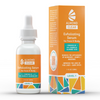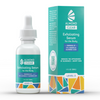Folliculitis Treatment
Folliculitis before and after 6 weeks application of Almond Clear Level 2. Folliculitis can occur on the body, face, or scalp.
What in the world is folliculitis?!
Folliculitis is the inflammation and infection of the hair follicles. Mild cases of folliculitis have a tendency to clear up on their own with minimal self-care tactics. However, some people experience more aggravating, chronic forms of folliculitis that are difficult to resolve. Chronic folliculitis often leaves us not only physically uncomfortable (burning, stinging and itching) but can also create insecurities about exposing the parts of our body that are affected (like wearing a swimsuit). So how do we treat this stubborn, embarrassing skin condition and get it to go away for good?!
Do I have folliculitis or acne?
Folliculitis and acne share many of the same characteristics, so it can be really hard to tell them apart. It is common for people to be diagnosed with acne, when in reality, folliculitis is what they are dealing with. Also, to make self-diagnosis even more tricky, some people start out with acne and are prescribed antibiotics by a dermatologist. The antibiotics can throw the skin’s microbiome out of whack, resulting in bad cases of fungal folliculitis. It’s not uncommon for people to struggle with both conditions, or to start out with acne and then develop folliculitis.
Acne and folliculitis look very similar, but one defining characteristic of folliculitis is itching! This is a good marker for anyone who is questioning the nature of their skin condition. Acne never itches. But to be absolutely sure, the best way to know which skin concern you’re dealing with is to visit a dermatologist.
Types of folliculitis
Not all folliculitis is the same and therefore we can’t treat them in the same way. There are two broad categories of folliculitis; bacterial and fungal. There are actually more types of folliculitis, but to keep this article streamlined, we’ll focus on the two types of folliculitis that the majority of people experience.
Bacterial folliculitis often presents with white, itchy, puss-filled bumps. Boils also fall into the bacterial category. Boils are characterized as a painful red bump or cluster of bumps and are often noticed after shaving a specific area. For instance, the face or bikini line. Sounds fun, right? Not so much.
Fungal folliculitis, or Malassezia folliculitis, produces itchy, red pustules on the body that are often found on the forehead, back, neck, upper arms, bum and shoulders (see here for example images). This type of folliculitis is commonly seen in people who live in warm climates or enjoy working out, doing yard-work, or who are athletes.
Bacterial and fungal folliculitis need to be treated slightly differently, so it’s important to know which one you’re dealing with. Bacterial folliculitis responds well to acne treatment products, and it’s less likely to be aggravated by ingredients in personal care products. In comparison, fungal folliculitis is much trickier to clear up. It doesn’t respond to typical acne treatment products, and it can be exacerbated by a huge range of ingredients in personal care products. You can find a wealth of information about fungal folliculitis-safe products at Simple Skincare Science.
Non-medical treatment of folliculitis
First, it is important to figure out which type of folliculitis you have. If possible, it’s best to see a dermatologist in order to get an accurate diagnosis. If you can’t afford to see a dermatologist, then you can try to self-diagnose. If your folliculitis doesn’t respond to any of the typical acne treatment products and can be easily aggravated by your other personal care products, then it’s likely the fungal variety. Conversely, if you’ve had moderate success with acne treatment, then you’re likely dealing with bacterial folliculitis.
Your next step is to remove any environmental factors that could be contributing to your specific type and condition. For example, if you love using the hot tub at your gym, but notice your bacterial folliculitis is exacerbated by pool/hot tub exposure; it may then you’ll need to omit swimming from your gym routine.
Another example of changing environmental factors is razor bumps. This irritation is often caused by “too close of a shave” and inadequate pre-exfoliation before hair removal. To remove this environmental factor, find a razor that doesn’t shave right next to the skin. There are many razors designed for African American men, like Bevel products, that can help prevent shaving-induced folliculitis.
First Steps To Combat Folliculitis:
- What type of folliculitis do you have? [see a dermatologist for a true diagnosis]
- Consider environmental factors that could be contributing to your folliculitis and adjust accordingly
Once you have narrowed down what type of folliculitis you have and removed any environmental factors, it is time to consider treatments that will help clear your skin!
Exfoliation is key when treating folliculitis. Unclogging the follicles will help prevent bacteria and fungus from growing in the follicles. Also, look for products that are both antifungal and antibacterial. This is a win-win for those who deal with all types of folliculitis!
So let’s look at some ingredients to look for when treating both bacterial and fungal folliculitis. Whatever
Some Anti-microbial ingredients
- Mandelic acid serums and cleansers (a good choice for both types of folliculitis: it’s antibacterial, antifungal, and exfoliating)
- Ketoconazole cleansers or shampoo (for fungal folliculitis only)
- Antibacterial soap (2x daily, for bacterial folliculitis only)
- Azelaic acid serums and cleansers
- Salicylic acid serums and cleansers
- Malic acid serums and cleansers
- Urea serums and cleansers
- Aloe vera (use ONLY pure aloe vera)
- Epsom salt bath or compress
The importance of moisturizer and a healthy skin barrier
Lastly, do NOT skip a moisturizer at night and use an SPF every single day! Many people with acne and folliculitis-prone skin are hesitant to use a moisturizer. Oftentimes, people fear that applying a moisturizer will cause them to break out or make their folliculitis worse. Nothing could be further from the truth! It is very important to keep your skin hydrated to help balance oil production and keep your skin barrier intact.
It’s very common for people who suffer from acne and folliculitis to have a compromised skin barrier. What does this mean? The skin barrier is the outermost layers of skin. This barrier layer is healthy and fully functional when it is moist, rich in proteins and nutrients, and has the right microbial balance. A healthy skin barrier protects against external aggressors that can damage and break out your skin.
In contrast, a compromised skin barrier is dry, nutrient-deprived, and easily penetrated by irritants that further weaken your skin. This weakening can occur with acne and folliculitis suffers when they aggressively exfoliate their skin without applying hydrating and nourishing products. When the barrier has been compromised, you can expect more breakouts and folliculitis flare ups. Also, when skin has been over-exfoliated (hello, chronically dry/flaky skin!) your body gets confused. Over exfoliation causes your body to release signals to produce more oil! This can be a vicious cycle for people who deal with acne and breakouts. All of this shows why it’s so important to regularly apply a nourishing, high-quality moisturizer.
Almond Clear has come out with a Soothing Daily Moisturizer that is a great choice. It is a creamy and lightweight moisturizer that is hydrating and soothing. It quickly absorbs and leaves no heavy residue. It is also safe for acne & folliculitis-prone skin.
You can find an exhaustive list of folliculitis-safe moisturizers at the Simple Skincare Science blog.
Folliculitis-safe SPF
Using an SPF is important because the exfoliating properties of skincare acids will cause your skin to be more sensitive to UVA/UVB light. Overexposure to the sun's rays can create long-term damage and premature aging, both of which can be time-consuming and costly to correct. Most sunscreens are not safe for folliculitis, but there are a few that are suitable for folliculitis-prone skin. This article by Simple Skincare Science lists the sunscreens that won’t cause folliculitis to flare up.
To sum it up
Folliculitis is an inflammation and infection of the hair follicles that can look very similar to acne. There are many types of folliculitis, and they fall into the broad categories of fungal and bacterial folliculitis. It’s important to figure out what type you have so that you can choose the right treatment products. Bacterial folliculitis often responds to typical acne treatment products, but fungal folliculitis requires a more careful, targeted approach. In addition to finding the right treatment, it’s also important to eliminate environmental factors that could be aggravating your folliculitis. Finally, don’t forget to moisturize your skin and use SPF so that you can maintain a healthy skin barrier.
Article Co-Authored by Kristin Holmberg of Elite Aesthetics PDX & Leslie Eisen, Almond Clear founder)







